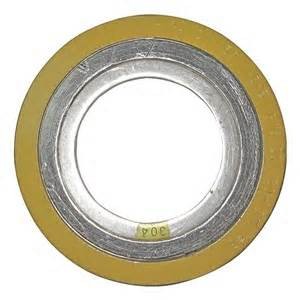
The Spiral Wound Gaskets are the first choice of many industries due to their ability to withstand high fluctuating temperatures, high pressures, and corrosive substances. The gasket's design delivers an effective seal without adding a lot of extra weight, making it less expensive to transport than many other sealing options.
One essential component of the spiral-wound gasket is the metallic strip, which is typically made from stainless steel, while the non-metallic portion may be composed of various materials such as PTFE, graphite, and ceramics. These materials are selected according to their resistance to high-temperature and corrosive environments.
Spiral Wound Gaskets finds use in a wide variety of applications across many different industries, but they are particularly useful for sealing applications in the oil and gas, chemical, and power generation industries.
The Spiral Wound Gaskets boasts significant advantages over other sealing options. They are more resistant to wear and tear, ensuring a longer lifespan. They also provide better sealing capabilities at high temperatures and pressures, making them ideal for industrial settings. Additionally, Spiral Wound Gaskets offer flexibility, allowing them to be used in a variety of applications.
When selecting a Spiral Wound Gasket, there are several factors that one must consider, such as the size, shape, and temperature and pressure requirements of the application. The gasket's material composition is also essential, and it should match the environment it will be used in.
In conclusion, the Spiral Wound Gaskets is an efficient and reliable industrial sealing solution, widely used in the oil and gas, chemical and power generation industries. It is a combination of metallic strips wound V-shaped and soft fillers, which provides strength, resiliency, and sealing properties. Choosing the right Spiral Wound Gasket for your application requires you to understand all the factors that influence gasket performance.
As a leading provider of sealing solutions, Ningbo Kaxite Sealing Materials Co., Ltd. is committed to producing high-quality Spiral Wound Gaskets. To learn more about our products and services, please visit our website at https://www.top-seals.com. For further inquiries, you can reach out to us via email at [email protected].
1. John, M.(2014). Performance of the Spiral Wound Gasket at High Temperatures. Chemical Engineering News, 56(1), 47-53.
2. Zhou, G., Scholte, H. A. (2017). The Effect of Material Selection on the Performance of Spiral Wound Gaskets. Journal of Pressure Vessel Technology, 139(3), 348-355.
3. Rajeswari, N., & Jaisankar, S. N. (2019). A Critical Review of Spiral Wound Gaskets Used in Petrochemical Industries. Journal of Multidisciplinary Engineering Science and Technology, 6(2), 3554-3561.
4. Chung, Y., & Kim, Y. (2015). A Comparative Study on the Performance of Spiral Wound Gaskets. Journal of Mechanical Science and Technology, 29(7), 2753-2760.
5. Maiti, R., Saha, P., & Adak, S. (2020). Investigating the Effect of Filler Material on Leakage of Spiral Wound Gaskets. Engineering Reports, 2(1), e11992.
6. Folli, A., & Rangaswamy, S. (2016). The Effect of Operating Pressure and Temperature on the Performance of Spiral Wound Gaskets. Journal of Engineering Failure Analysis, 63, 214-221.
7. Thomas, J., & Shaji, A. M. (2018). Development and Characterization of Spiral Wound Gaskets for High-Temperature Sealing Applications. Journal of Materials Engineering and Performance, 27(1), 27-33.
8. Kumar, L., & Singh, H. R. (2017). The Effect of Fluctuating Temperature on the Performance of Spiral Wound Gaskets. Journal of Manufacturing Processes, 29, 72-75.
9. Zhang, S. (2017). The Role of Gasket Sealing in Preventing Flange Leakage in Corrosive Environments. Corrosion Engineering, Science and Technology, 52(3), 227-232.
10. Ghosh, S., & Singh, G. (2019). On the Optimization of Spiral Wound Gaskets for High-Pressure Sealing Applications. Journal of Materials Research and Technology, 8(3), 3339-3346.
TradeManager
Skype
VKontakte
